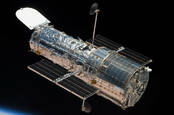This article is more than 1 year old
NASA renames dark-energy telescope after its first Chief of Astronomy and Mother of Hubble: Nancy Grace Roman
Boffin immortalized, praised for her 'leadership and vision'
Video NASA has renamed its forthcoming Wide Field Infrared Survey Telescope (WFIRST) after the agency’s first Chief of Astronomy, Nancy Grace Roman, who drove the Hubble project and pushed for a computing-based approach to sky scanning.
The space telescope's new name, The Nancy Grace Roman Telescope, was unveiled by NASA Administrator Jim Bridenstine on Wednesday. It'll carry a 2.4-metre mirror that will focus light onto two cameras: its Wide-Field Instrument, and the Coronagraphic Instrument.
The Wide-Field Instrument uses 18 sensors, each one 4096 x 4096 pixels, to detect infrared light from distant galaxies at about the same resolution as the Hubble Space Telescope. Crucially, though, it has a viewing field 100 times wider, allowing stunning vistas to be captured. The Coronagraphic Instrument is an exoplanet hunter using high-contrast imaging and spectroscopy to sniff out worlds orbiting far-away suns. The telescope is expected to launch in the next three years, and all of its collected data will be open sourced for anyone to use.
“It is because of Nancy Grace Roman’s leadership and vision that NASA became a pioneer in astrophysics and launched Hubble, the world’s most powerful and productive space telescope,” said Bridenstine. “I can think of no better name for WFIRST, which will be the successor to NASA’s Hubble and Webb Telescopes.”
The space agency's video below summarizes the telescope's mission:
NASA hopes to use the Roman space 'scope to investigate dark energy and dark matter's effects on the universe as well as study exoplanets and infrared astrophysics. The probe will analyze countless galaxies, and detect supernova explosions and alien worlds orbiting parent stars. All of these readings will help us understand how galaxies and their planetary systems form and evolve over time as the universe expands.
Nancy Grace Roman, the 'Mother of Hubble'
Since the spacecraft will be peering into the distant depths of the universe to understand how it expanded over time from its origins, it’s only fitting to name it after Roman, who was present when NASA was formed more than 60 years ago. Roman joined in 1959 when the organization had been around for just six months. By the time she joined, she was already well known for her research into galaxies, stars, and exoplanets. Initially, her career was difficult and began during a time when women were not readily accepted as scientists.
Although she graduated with a doctorate in astronomy from the University of Chicago, she was often overlooked and her thesis advisor William Wilson Morgan did not even speak to her for six months whenever she greeted him. In 1954, she proposed using a new-fangled digital computer to analyze astronomical observations, but was turned down. Nevertheless she continued to push for using computers to aid human exploration.
Roman went to work at the Naval Research Laboratory as a radio astronomer, where she was the first to use radar imaging to measure the distance to the Moon more accurately.
She presented her findings at a conference in 1959, and was approached by Jack Clark at NASA, who was looking for someone to kickstart its space astronomy program. Roman applied for the role and was accepted, which made her NASA’s first Chief of Astronomy and the first woman to hold an executive position at the male-dominated space agency, where she worked for 20 years. Roman, born in 1925, died on Christmas Day in 2018.
Elisa Quintana, an astrophysicist at NASA’s Goddard Space Center, said: “She really advocated for putting astronomy instruments in space. NASA doesn’t just build missions for the science we know today, we needed visionaries like Grace to understand the unknown mysteries of space.”
Roman is most well known for her work on NASA’s Hubble Space Telescope; she was later known as the Mother of Hubble. “Nancy Grace Roman was the driving force behind Hubble,” said Julie McEnery, Fermi Project Scientist and astrophysicist also working at Goddard. "She was the one person that made that mission possible. She had the science, technical, and management skills to bring all these things together to make Hubble happen."
The Hubble Space Telescope is one of NASA’s most successful and iconic missions. As of April, it’s been in space for more than 30 years. ®

